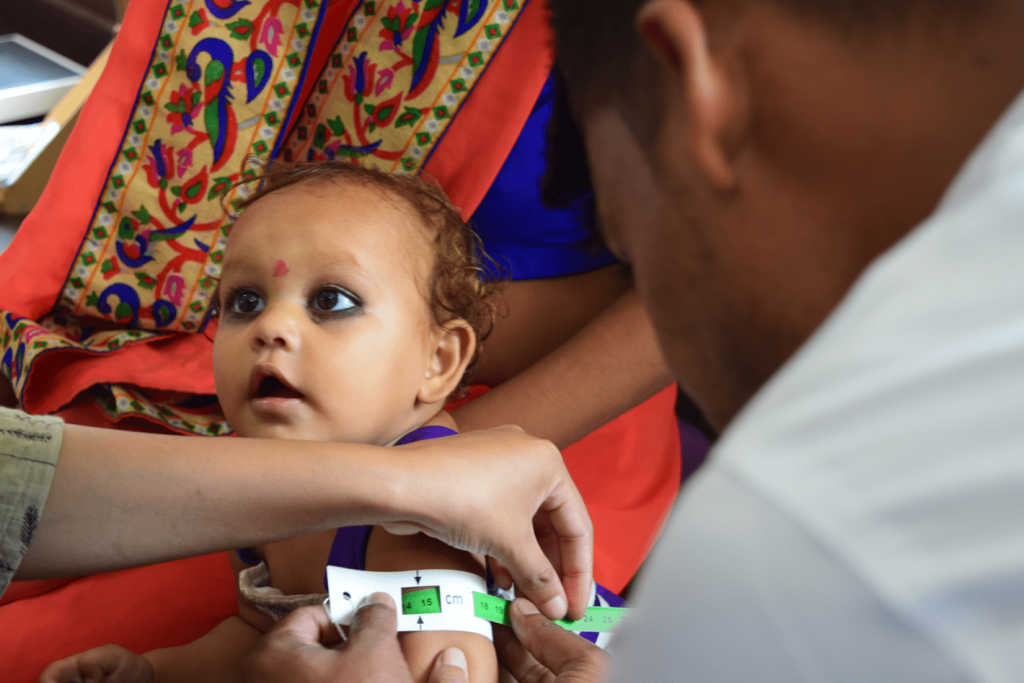During any kind of pandemic or epidemic, children are the first ones to get affected. Infants and children are the most vulnerable population group who gets exposed to food insecurities during such emergencies. This year, outbreak of COVID-19 and the eventual government-imposed lockdown took a serious toll on the lives of the vulnerable families, especially children. In many places, food distribution, health services, livelihoods and local markets came to a standstill which severely affected children between the age group of 6 to 59 months of age. Immediate disruption of Anganwadi services suspended anthropometric measurements of the children which are otherwise regularly taken. In such a scenario and looking at the severity of an imminent hunger crisis, Welthungerhilfe’s Child Growth Monitoring (CGM) team, without wasting much time, returned to the field to assess the nutritional status of children and aimed to empower mothers and make them self-reliant. The skilled CGM team who is authorized to take accurate anthropometric measurements (after passing standardized test as per SMART survey methodology), reached out to mothers on an individual basis considering the CVOID-19 restrictions. Mothers were trained on MUAC (mid-upper-arm-circumference) measurement to learn how to identify the early signs of malnutrition in their children.
Empowering mothers in nutrition screening activity is vital as they are best placed to identify early signs of malnutrition. This reinforces their role in protecting and promoting their child’s health better than anyone else in the community. In a post COVID-19 scenario, the aim is to identify these selected mothers and train them on using the CGM application.
Introducing mother’s MUAC
Mother’s MUAC implementation screening comes as an approach where mothers are trained to screen their child for acute malnutrition by taking MUAC measurement of the child’s left arm. The MUAC measurement is undertaken by using a simple tri colour tape standardized by UNICEF which enables a mother, caregivers or a community worker to identify if a child is at risk of under-nutrition or not.

It is a simple technique where a mother is guided on how to use the tape on a child’s arm and interpret it to see if the child is growing nutritionally. During the pandemic, in the absence of regular growth monitoring by the health system, ‘mother’s MUAC’ ensures to identifying children at risk of acute malnutrition at an early stage. It also enables the process to bring a child back to nutritional and healthy stage. Involving mothers in nutrition screening activities ascertains the fact that they are the best protector and monitor to identify early signs of malnutrition in their children. It also reinforces healthy practices in protecting and promoting their child’s health in any circumstances mostly during pandemics such as COVID-19.
The mother’s MUAC approach has been introduced in the CGM project locations on Rajasthan and Madhya Pradesh. The CGM teams reached out to the district administration and sought their approval to implement the trainings with support from the Anganwadi workers.

Training mothers
When the CGM team of Darshna Mahila Kalyan Samiti (DMKS) team visited Shanti’s family in Rajnagar block in Chhatarpur district of Madhya Pradesh, for the regular health assessment of her children, she was confident that she wanted to learn and take control of her children’s well-being. Despite a very busy daily schedule she was eager to learn about MUAC measurements. Shanti became part of a pilot group for this approach. DMKS team closely worked with her and trained her on the nitty-gritties of the task.
When Shanti started in June 2020, she found her one-year old son Rishi to be under red colour category meaning to be severely acute malnourished (SAM). This screening provoked her to seek help from the local Aanganwadi worker (ICDS community worker) and ASHA (health community worker) to admit her child to the nearest Nutritional Rehabilitation Centre (NRC). However, the ongoing COVID-19 scenario made her apprehensive to admit Rishi to the health centre. She was scared that he might get exposed to the virus. However, after providing serious counselling by the CGM team of DMKS, Shanti decided to admit Rishi to the health centre.
“I have gained a lot of confidence after the training. I can now monitor the growth of my children at home,” shares Shanti. Having such a confidence to identify the problem and self-referral to seek treatment not only empowered a homemaker like Shanti but also saved Rishi from developing further complication for being a SAM child. Shanti ensured that Rishi received his complete treatment at the NRC. He eventually progressed from the red (severely malnourished) to yellow category (moderately malnourished). Now, taking regular growth measurement of her children has become part of Shanti routine work. She measures them with the MUAC tape every week and is proud of being their nutrition and health guardian. “Now, I have become a perfect caretaker for my children”, says Shanti.
Like Shanti, a total of 1318 mothers have been trained by both Welthungerhilfe partners DMKS and ACF across the states of Madhya Pradesh and Rajasthan. Each mother was supported with hands-on practical demonstrations of using MUAC tape to ensure they understood the process of recording the MUAC measurement of their child. Every trainer ensured that they inform mother on the importance of regular screening and eventually make them digitally literate on the CGM application.




